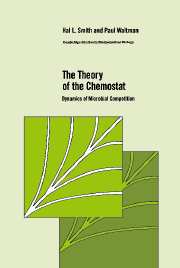Book contents
- Frontmatter
- Contents
- Preface
- 1 The Simple Chemostat
- 2 The General Chemostat
- 3 Competition on Three Trophic Levels
- 4 The Chemostat with an Inhibitor
- 5 The Simple Gradostat
- 6 The General Gradostat
- 7 The Chemostat with Periodic Washout Rate
- 8 Variable-Yield Models
- 9 A Size-Structured Competition Model
- 10 New Directions
- 11 Open Questions
- Appendices
- References
- Author index
- Subject index
7 - The Chemostat with Periodic Washout Rate
Published online by Cambridge University Press: 07 December 2009
- Frontmatter
- Contents
- Preface
- 1 The Simple Chemostat
- 2 The General Chemostat
- 3 Competition on Three Trophic Levels
- 4 The Chemostat with an Inhibitor
- 5 The Simple Gradostat
- 6 The General Gradostat
- 7 The Chemostat with Periodic Washout Rate
- 8 Variable-Yield Models
- 9 A Size-Structured Competition Model
- 10 New Directions
- 11 Open Questions
- Appendices
- References
- Author index
- Subject index
Summary
Introduction
The results of Chapters 1 and 2 demonstrate that coexistence cannot occur in the chemostat with constant values of the operating parameters (the washout rate D and the input nutrient concentration S0). Roughly speaking, in a temporally homogeneous (constant operating parameters) and spatially homogeneous (well-stirred chemostat) environment, the model predicts competitive exclusion. Of course, real environments are far from being homogeneous, either in space or in time. In addition to the day–night variability in the environment, there are both seasonal effects and random effects caused by the variable climate. In this chapter, the simple chemostat model of competition will be modified to create a periodically varying environment, and it will be shown that coexistence of the two competitors can occur.
There are two basic ways to modify the chemostat model to create a periodic environment – make the reservoir nutrient concentration S0 vary periodically in time, or make the washout rate D vary periodically. The first modification was studied by Hale and Somolinos [HaS], Hsu [Hsu2], Smith [S1], and Stephanopoulos, Fredrickson, and Aris [SFA]. This study is natural from the ecological point of view, as nutrient levels in many ecosystems might be expected to vary with the day–night cycle or with the season. The second modification was studied by Butler, Hsu, and Waltman [BHW2] and in [SFA].
- Type
- Chapter
- Information
- The Theory of the ChemostatDynamics of Microbial Competition, pp. 159 - 181Publisher: Cambridge University PressPrint publication year: 1995



